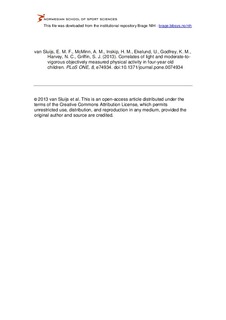| dc.contributor.author | van Sluijs, Esther M. F. | |
| dc.contributor.author | McMinn, Alison M. | |
| dc.contributor.author | Inskip, Hazel M. | |
| dc.contributor.author | Ekelund, Ulf | |
| dc.contributor.author | Godfrey, Keith M. | |
| dc.contributor.author | Harvey, Nicholas C. | |
| dc.contributor.author | Griffin, Simon J. | |
| dc.date.accessioned | 2014-03-14T10:21:25Z | |
| dc.date.available | 2014-03-14T10:21:25Z | |
| dc.date.issued | 2013-09-05 | |
| dc.identifier.citation | PLoS ONE. 2013, 8, e74934 | nb_NO |
| dc.identifier.uri | http://hdl.handle.net/11250/191614 | |
| dc.description | © 2013 van Sluijs et al. | nb_NO |
| dc.description.abstract | Background: Correlates of physical activity (PA) are hypothesized to be context and behaviour specific, but there is limited evidence of this in young children. The aim of the current study is to investigate associations between personal, social and environmental factors and objectively measured light and moderate-to-vigorous PA (LPA and MVPA, respectively) in four-year-old children.
Methods: Cross-sectional data were used from the Southampton Women’s Survey, a UK population-based longitudinal study. Four-year old children (n = 487, 47.0% male) had valid PA data assessed using accelerometry (Actiheart) and exposure data collected with a validated maternal questionnaire (including data on child personality, family demographics, maternal behaviour, rules and restrictions, and perceived local environment). Linear regression modelling was used to analyse associations with LPA and MVPA separately, interactions with sex were explored.
Results: LPA minutes were greater in children whose mothers reported more PA (vs. inactive: regression coefficient±standard error: 6.70±2.94 minutes), and without other children in the neighbourhood to play with (−6.33±2.44). MVPA minutes were greater in children with older siblings (vs. none: 5.81±2.80) and those whose mothers used active transport for short trips (vs. inactive: 6.24±2.95). Children accumulated more MVPA in spring (vs. winter: 9.50±4.03) and, in boys only, less MVPA with availability of other children in the neighbourhood (−3.98±1.70).
Discussion: Young children’s LPA and MVPA have differing associations with a number of social and environmental variables. Interventions targeting PA promotion in young children outside of formal care settings should consider including intensity specific factors. | nb_NO |
| dc.language.iso | eng | nb_NO |
| dc.publisher | PLOS.org | nb_NO |
| dc.subject | VDP::Matematikk og Naturvitenskap: 400::Basale biofag: 470 | nb_NO |
| dc.subject | VDP::Landbruks- og Fiskerifag: 900::Landbruksfag: 910 | nb_NO |
| dc.subject | accelerometers | nb_NO |
| dc.subject | age groups | nb_NO |
| dc.subject | behavior | nb_NO |
| dc.subject | child health | nb_NO |
| dc.subject | childhood obesity | nb_NO |
| dc.subject | children | nb_NO |
| dc.subject | mothers | nb_NO |
| dc.subject | population groupings | nb_NO |
| dc.title | Correlates of light and moderate-to-vigorous objectively measured physical activity in four-year old children | nb_NO |
| dc.type | Journal article | nb_NO |
| dc.type | Peer reviewed | nb_NO |
| dc.source.journal | PLoS ONE | nb_NO |
| dc.identifier.doi | 10.1371/journal.pone.0074934 | |
| dc.description.localcode | Seksjon for idrettsmedisinske fag / Department of Sport Sciences | nb_NO |
